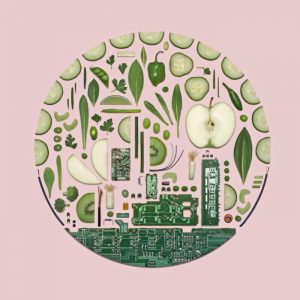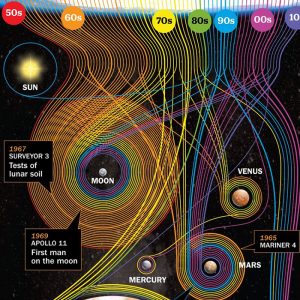Link About It: This Week’s Picks
60 years of NASA, life imitating art, food technology, data privacy and more

Judy Chicago’s Portrayal of Toxic Masculinity Appears in Real Life
 Judy Chicago‘s 1985 series Three Faces of Man occurred in real-life this past week—seen in the outrage of powerful, petulant men unaccustomed to answering for their behavior. Chicago’s painting was unveiled in 1985, but it’s clearly as relevant as ever. As Jonathan D Katz writes for Artsy, “What was once allegory is now reportage, and Chicago’s art from decades past has never looked so current.” While exploring the concept of men’s behavior and actions, Chicago says she found, “The prohibitions around openly expressing feelings—particularly of vulnerability as expressed in tears—caused innumerable personality distortions.” Read more at Artsy.
Judy Chicago‘s 1985 series Three Faces of Man occurred in real-life this past week—seen in the outrage of powerful, petulant men unaccustomed to answering for their behavior. Chicago’s painting was unveiled in 1985, but it’s clearly as relevant as ever. As Jonathan D Katz writes for Artsy, “What was once allegory is now reportage, and Chicago’s art from decades past has never looked so current.” While exploring the concept of men’s behavior and actions, Chicago says she found, “The prohibitions around openly expressing feelings—particularly of vulnerability as expressed in tears—caused innumerable personality distortions.” Read more at Artsy.
Art Fairs Descend Upon London for Frieze Week
 From Old Masters to contemporary African art, many prestigious fairs will temporarily open for London’s Frieze Week. Frieze London and Frieze Masters—in Regent’s Park—will once again be the anchor event, but this year sees many other pop-ups worth visiting. There’s 1-54 Contemporary African Art Fair at Somerset House, PAD London at Mayfair’s Berkeley Square, plus Moniker and Sunday art fairs kick off in the city, as well. Head over to artnet News for more information.
From Old Masters to contemporary African art, many prestigious fairs will temporarily open for London’s Frieze Week. Frieze London and Frieze Masters—in Regent’s Park—will once again be the anchor event, but this year sees many other pop-ups worth visiting. There’s 1-54 Contemporary African Art Fair at Somerset House, PAD London at Mayfair’s Berkeley Square, plus Moniker and Sunday art fairs kick off in the city, as well. Head over to artnet News for more information.
Neptune-Sized Moon Discovered Outside Our Solar System
 Some 8,000 light-years away, a moon has been discovered—possibly the first one outside our own solar system. Dubbed an “exomoon,” the “Neptune-sized” gassy object, which orbits a “Jupiter-sized” planet, was spotted by Columbia University astronomers via the Kepler and Hubble space telescopes. It’s “unlike anything scientists have seen before, and even if this turns out to be a false find, the experience has offered valuable insight on how to find a possible moon by surveying the planet first. Learn more at the Washington Post.
Some 8,000 light-years away, a moon has been discovered—possibly the first one outside our own solar system. Dubbed an “exomoon,” the “Neptune-sized” gassy object, which orbits a “Jupiter-sized” planet, was spotted by Columbia University astronomers via the Kepler and Hubble space telescopes. It’s “unlike anything scientists have seen before, and even if this turns out to be a false find, the experience has offered valuable insight on how to find a possible moon by surveying the planet first. Learn more at the Washington Post.
New Technology Hopes to Transform the Food Industry
 The food industry has garnered near universal flack for its lack of transparency, mistreatment of animals and environmental impact. Rightfully so in some instances, but technology hopes to alleviate the issues that some producers and consumers otherwise cannot avoid. Foodini, for instance, is a 3D printer that replaces typical plastic ink with edible ingredients, allowing home-cooks and chefs the ability to make an exact amount of something with repetitious likeness. Another innovation, called Apeel, will use the leftovers in a wine press to coat perishable fruits and produces with an invisible and tasteless layer that can extend shelf-life threefold. Read more about the technologies that are hoping to revolutionize food production and consumption at the Wall Street Journal.
The food industry has garnered near universal flack for its lack of transparency, mistreatment of animals and environmental impact. Rightfully so in some instances, but technology hopes to alleviate the issues that some producers and consumers otherwise cannot avoid. Foodini, for instance, is a 3D printer that replaces typical plastic ink with edible ingredients, allowing home-cooks and chefs the ability to make an exact amount of something with repetitious likeness. Another innovation, called Apeel, will use the leftovers in a wine press to coat perishable fruits and produces with an invisible and tasteless layer that can extend shelf-life threefold. Read more about the technologies that are hoping to revolutionize food production and consumption at the Wall Street Journal.
From The Seeds Up: The Future of Fruits and Vegetables
 At New York’s first-ever Variety Showcase—organized by the Culinary Breeding Network from Oregon, and GrowNYC—chefs, plant-breeders, farmers and others in the food industry joined together to discuss and present examples of the future of produce. One of the many goals of the showcase includes developing ideas—and in-turn seeds—that produce foods which taste better, reduce waste and meet the specific needs of chefs and cooks. While much of these “bespoke seeds” result in out-of-the-ordinary fruits and vegetables, each serves a specific, and arguably necessary, purpose. Read more about the futuristic developments and learn about specific farm-to-table ingredients (like Deep Purple kale) at Grub Street.
At New York’s first-ever Variety Showcase—organized by the Culinary Breeding Network from Oregon, and GrowNYC—chefs, plant-breeders, farmers and others in the food industry joined together to discuss and present examples of the future of produce. One of the many goals of the showcase includes developing ideas—and in-turn seeds—that produce foods which taste better, reduce waste and meet the specific needs of chefs and cooks. While much of these “bespoke seeds” result in out-of-the-ordinary fruits and vegetables, each serves a specific, and arguably necessary, purpose. Read more about the futuristic developments and learn about specific farm-to-table ingredients (like Deep Purple kale) at Grub Street.
World Wide Web Inventor’s New Personal Data Project
 Tim Berners-Lee, the inventor of the World Wide Web, hopes to help internet users reclaim their personal data—and ultimately their privacy. His newest project, Solid, is a place to store information. Users can take the data with them and transfer it immediately to any app, workspace or website (if they agree to). “Solid is a platform, built using the existing web. It gives every user a choice about where data is stored, which specific people and groups can access select elements, and which apps you use. It allows you, your family and colleagues, to link and share data with anyone. It allows people to look at the same data with different apps at the same time,” Berners-Lee says. Read more about the power-to-the-people project at 9to5Mac.
Tim Berners-Lee, the inventor of the World Wide Web, hopes to help internet users reclaim their personal data—and ultimately their privacy. His newest project, Solid, is a place to store information. Users can take the data with them and transfer it immediately to any app, workspace or website (if they agree to). “Solid is a platform, built using the existing web. It gives every user a choice about where data is stored, which specific people and groups can access select elements, and which apps you use. It allows you, your family and colleagues, to link and share data with anyone. It allows people to look at the same data with different apps at the same time,” Berners-Lee says. Read more about the power-to-the-people project at 9to5Mac.
60 Years of NASA
 In 1958, NASA (National Aeronautics and Space Administration) was formed after the Soviet Union launched their Sputnik satellite into the cosmos, and ever since the agency has explored distant worlds. In a sprawling graphic (made by a team consisting of Emily Barone, Jeffrey Kluger and Lon Tweeten) every NASA spacecraft ever launched is noted, tracked and dated. Excluding tests and failed missions, the list spans the ’50s through today—from the moon to Mars and beyond. Zooming out and viewing the USA’s obsession with space sheds light on how far we’ve gone, and concurrently, how little we’ve really seen. See more at Time.
In 1958, NASA (National Aeronautics and Space Administration) was formed after the Soviet Union launched their Sputnik satellite into the cosmos, and ever since the agency has explored distant worlds. In a sprawling graphic (made by a team consisting of Emily Barone, Jeffrey Kluger and Lon Tweeten) every NASA spacecraft ever launched is noted, tracked and dated. Excluding tests and failed missions, the list spans the ’50s through today—from the moon to Mars and beyond. Zooming out and viewing the USA’s obsession with space sheds light on how far we’ve gone, and concurrently, how little we’ve really seen. See more at Time.
Adobe Unveils an All-New Acrobat DC
 Adobe’s all-new Acrobat DC aims to streamline the review process for creatives—thanks to new tools that make sharing PDFs with clients much easier. The program acts as a kind of hub—hosted on Adobe Document Cloud—where designers can offer access to their work to anyone via link or invite, check to see if invitees have looked yet, set deadlines and reminders, view feedback and more. Taking much of the dread out of sharing projects for review, this new system could be a game-changer. Read more about the update at Adobe.
Adobe’s all-new Acrobat DC aims to streamline the review process for creatives—thanks to new tools that make sharing PDFs with clients much easier. The program acts as a kind of hub—hosted on Adobe Document Cloud—where designers can offer access to their work to anyone via link or invite, check to see if invitees have looked yet, set deadlines and reminders, view feedback and more. Taking much of the dread out of sharing projects for review, this new system could be a game-changer. Read more about the update at Adobe.
Link About It is our filtered look at the web, shared daily in Link and on social media, and rounded up every Saturday morning.












